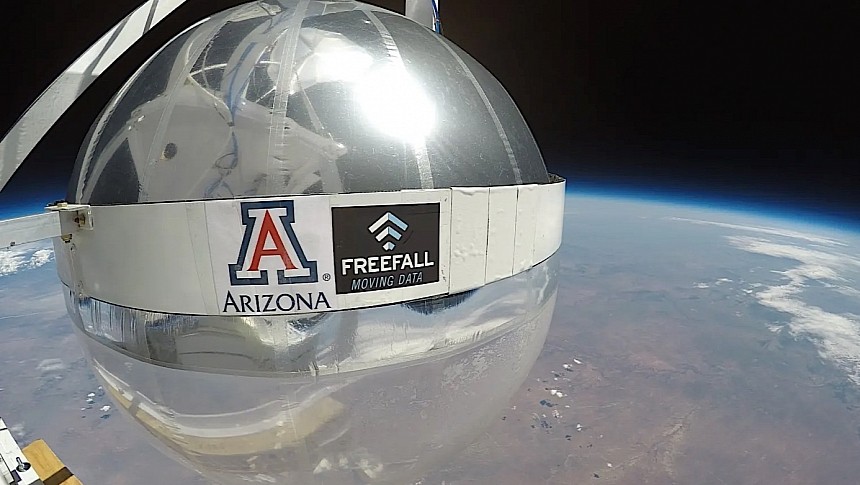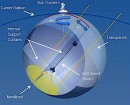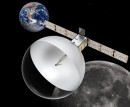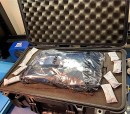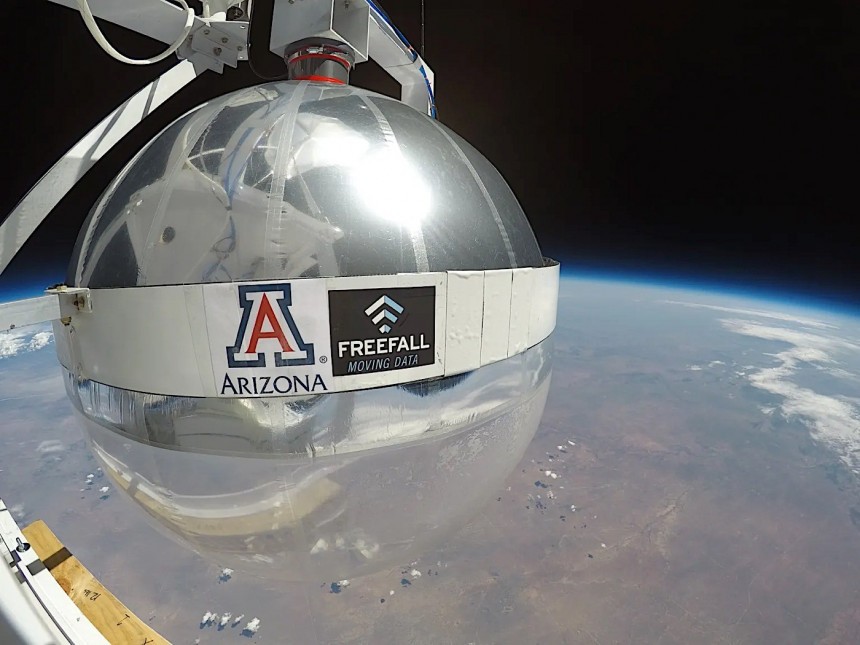Humanity would not have such an ambitious space exploration program if it weren't for advanced communications technology. Not only does it allow for spacecraft and other pieces of hardware to be remotely controlled, but it also allows for the two-way transmission of data, images, and in some cases even videos.
The current means of communicating with space hardware is by means of radio technology. Although limited in scope and reach (meaning, above all, it's not particularly fast), this method allows humans to do anything from controlling rovers and tiny helicopters on Mars to getting snapshots of alien worlds.
As the goals of our space missions expand and the distances increase, NASA is looking for new and better ways of communication. One avenue of research is the good old laser, which could allow for fast and massive data transfer through oscillations of light waves. Another is, essentially a giant space antenna.
Antennas are regularly used in space exploration. Take telescopes, for instance. Aside from the mirrors and other tech they need to look far and wide into the Universe, they use antennas to send their findings back to Earth. They also receive instructions about what they are supposed to do next this way.
Just like their counterparts here on Earth, many of them are parabolic dish antennas. That means concave (curved inward) structures meant to capture and concentrate electromagnetic radiation. The amount of data, but also the distance to and from which signals (light or radio waves) can be received depends greatly on the diameter of the antenna – something people in this business call aperture.
As said, there are plenty of antennas pointed at the Universe right here on Earth, but scientists would prefer to have them placed in orbit, away from the planet's atmosphere. The thing is a buzz killer and it greatly interferes with space signals.
But there's one big problem with that. The larger the antenna, the harder it is to place in orbit. Read that as heavy, bulky, and difficult to deploy.
Take the James Webb telescope, the biggest and most expensive such piece of tech our species has on deck. The thing's mirror, which it points at distant stars, is a massive 21 feet (6.5 meters) in diameter. There are two antennas it points back to Earth to receive instructions and send back data, a Ka-band high-gain one that's just 2 feet (0.6 meters) across, and an S-band medium-gain one that comes in at just 8 inches (0.2 meters).
But what if I told you NASA may have found a way to deploy an antenna larger than Webb's mirror? OK, it's not NASA that came up with the idea, but it funds it.
The tech is called Large Balloon Reflector (LBR), and is the brainchild of a guy named Christopher Walker, presently an astronomy and optical engineering professor at the University of Arizona in Tucson.
The LBR is technically a thin film balloon that occupies a very small space in a ship and can inflate once it reaches its destination to a much larger size. In doing so, it transforms into a parabolic dish that requires very little supporting hardware.
But wait, isn't a parabolic dish curved inward (concave), and a balloon quite the opposite, curved outward (convex)? That's true, but there is more than meets the eye with the LBR.
The balloon does not use its exterior surface as a dish, but the interior one. A third of that surface is covered by aluminum, getting reflective properties and effectively turning the insides of the balloon into the perfect dish.
The idea is so wacky it could only have been inspired by chocolate pudding and the plastic wrap that goes over it to keep it fresh.
You see, 30 years ago, when Walker was nowhere near being an astronomy and optical engineering professor at the University of Arizona, he was planning a nice evening in the company of chocolate pudding.
While making the desert, he was interrupted by a call from his mother, so he decided to put plastic wrap over the stuff and chat away. Because of the pudding's heat, the wrap had been drawn in, getting into a concave shape. In the middle of that shape, the overhead lightbulb shone in magnified form.
That's how NASA likes to tell the story of how the LBR came to be. Just like the bulb in the plastic wrap, comms and data can concentrate on the interior surface of the balloon, helping advance science and space exploration.
Walker put his idea into practice for the first time in 2018, when he used a stadium-sized stratospheric balloon to transport a 3.28-foot (one-meter) scale model of the LBR to an altitude of 159,000 feet (48,500 meters).
That demonstration was enough for the space agency to grant the idea funding through the NASA Innovative Advanced Concepts (NIAC) program. The money received this way allowed Walker to build a 33-foot-diameter (10 meters) LBR, it too sent to the stratosphere by means of a balloon. That's right, a balloon carrying another balloon.
Next on the agenda is to test the LBR's ability to deliver high-speed communications from low-Earth orbit. The tech is scheduled to fly with a hardware made of six CubeSats, on a mission scheduled to depart in March 2024. The mission is called Educational Launch of Nanosatellites (ELaNa) 43.
The LBR to be flown will inflate to a diameter of just 1.5 feet (45 cm), and send photos back to Earth to prove it works. If all goes according to plan, there is even an idea to test the technology on a Moon mission.
The LBR is actually even more revolutionary than described above. Although when looking back to Earth it will essentially be an antenna, it could be used as a telescope when pointed the other way.
For a balloon that's really something, isn't it?
As the goals of our space missions expand and the distances increase, NASA is looking for new and better ways of communication. One avenue of research is the good old laser, which could allow for fast and massive data transfer through oscillations of light waves. Another is, essentially a giant space antenna.
Antennas are regularly used in space exploration. Take telescopes, for instance. Aside from the mirrors and other tech they need to look far and wide into the Universe, they use antennas to send their findings back to Earth. They also receive instructions about what they are supposed to do next this way.
Just like their counterparts here on Earth, many of them are parabolic dish antennas. That means concave (curved inward) structures meant to capture and concentrate electromagnetic radiation. The amount of data, but also the distance to and from which signals (light or radio waves) can be received depends greatly on the diameter of the antenna – something people in this business call aperture.
As said, there are plenty of antennas pointed at the Universe right here on Earth, but scientists would prefer to have them placed in orbit, away from the planet's atmosphere. The thing is a buzz killer and it greatly interferes with space signals.
Take the James Webb telescope, the biggest and most expensive such piece of tech our species has on deck. The thing's mirror, which it points at distant stars, is a massive 21 feet (6.5 meters) in diameter. There are two antennas it points back to Earth to receive instructions and send back data, a Ka-band high-gain one that's just 2 feet (0.6 meters) across, and an S-band medium-gain one that comes in at just 8 inches (0.2 meters).
But what if I told you NASA may have found a way to deploy an antenna larger than Webb's mirror? OK, it's not NASA that came up with the idea, but it funds it.
The tech is called Large Balloon Reflector (LBR), and is the brainchild of a guy named Christopher Walker, presently an astronomy and optical engineering professor at the University of Arizona in Tucson.
The LBR is technically a thin film balloon that occupies a very small space in a ship and can inflate once it reaches its destination to a much larger size. In doing so, it transforms into a parabolic dish that requires very little supporting hardware.
The balloon does not use its exterior surface as a dish, but the interior one. A third of that surface is covered by aluminum, getting reflective properties and effectively turning the insides of the balloon into the perfect dish.
The idea is so wacky it could only have been inspired by chocolate pudding and the plastic wrap that goes over it to keep it fresh.
You see, 30 years ago, when Walker was nowhere near being an astronomy and optical engineering professor at the University of Arizona, he was planning a nice evening in the company of chocolate pudding.
While making the desert, he was interrupted by a call from his mother, so he decided to put plastic wrap over the stuff and chat away. Because of the pudding's heat, the wrap had been drawn in, getting into a concave shape. In the middle of that shape, the overhead lightbulb shone in magnified form.
Walker put his idea into practice for the first time in 2018, when he used a stadium-sized stratospheric balloon to transport a 3.28-foot (one-meter) scale model of the LBR to an altitude of 159,000 feet (48,500 meters).
That demonstration was enough for the space agency to grant the idea funding through the NASA Innovative Advanced Concepts (NIAC) program. The money received this way allowed Walker to build a 33-foot-diameter (10 meters) LBR, it too sent to the stratosphere by means of a balloon. That's right, a balloon carrying another balloon.
Next on the agenda is to test the LBR's ability to deliver high-speed communications from low-Earth orbit. The tech is scheduled to fly with a hardware made of six CubeSats, on a mission scheduled to depart in March 2024. The mission is called Educational Launch of Nanosatellites (ELaNa) 43.
The LBR to be flown will inflate to a diameter of just 1.5 feet (45 cm), and send photos back to Earth to prove it works. If all goes according to plan, there is even an idea to test the technology on a Moon mission.
The LBR is actually even more revolutionary than described above. Although when looking back to Earth it will essentially be an antenna, it could be used as a telescope when pointed the other way.
For a balloon that's really something, isn't it?
